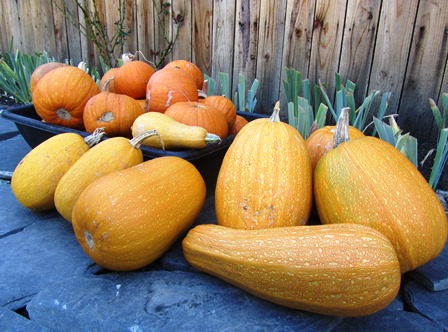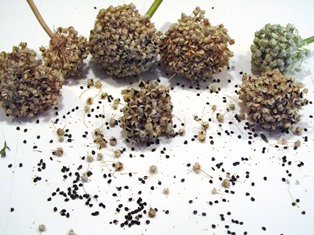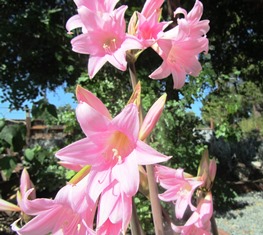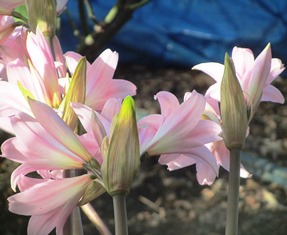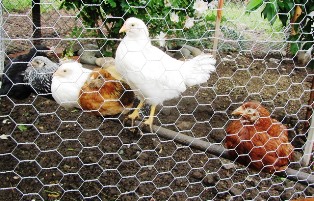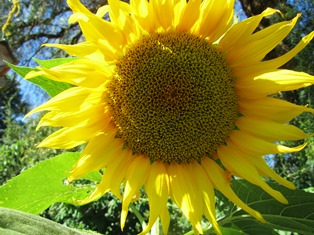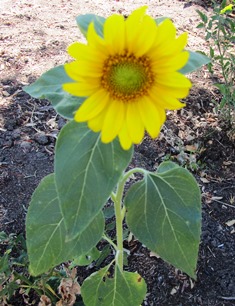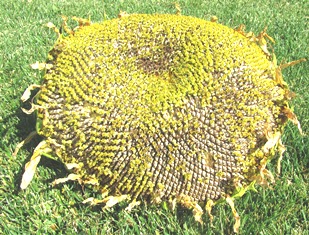Archive for the 'Gardening' Category
Pumpkin and Squash–Dealing with Vine Sprawl
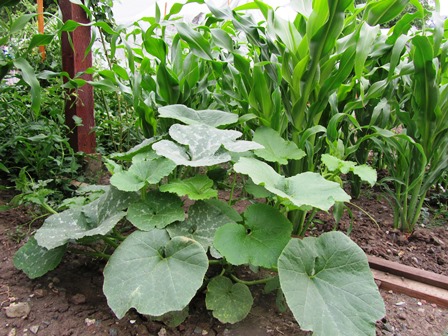
A squash plant will grow well in small gardens on supports such as a teepee of three poles tied together or on a fence
With the California drought looking like there’s no end in sight, I began pulling what I could from the garden. A lot of the space was taken up this year with squash and pumpkins. Vines are everywhere.
It’s my own fault for not keeping a better control over the direction of the vines. I could have grown them up and over a support, but I didn’t. Once ignored,the vines took over the whole garden, more than 25 to 30 feet in almost every direction.
I grew mainly heirloom varieties of squash and the French sugar pumpkins. One pumpkin plant reseeded from last year. Those vines climbed up into the five heirloom tomato plants, two apricot trees, and headed out toward the Lady Banks Rose and the Climbing Sally Holmes roses that border the garden. Inching even further, the squash vines moved out of the garden into the back yard.
No doubt about it, I’m going to have to pull on work gloves and a straw hat and get out there to dig out those dried vines and pull them out. Next year, trellises and supports for everything. Water is a commodity in crisis right now, at least in this state and everyone has to do their part. We’re just going to harvest the squash and pumpkins early and pray for early rains.
Scented Geraniums
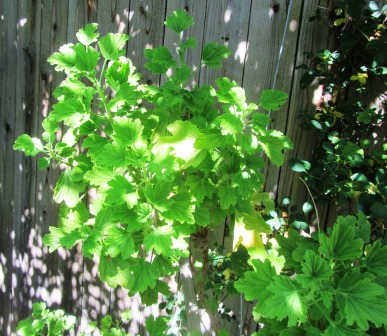
This lemon-scented Pelargonium crispum thrives in part shade and produces inch-wide, white-and-pink blooms
Brushing up against the leaves of a scented geranium releases fragrance to the area where they grow. It’s the main reason why these varieties are grown because those that bloom do not flower as colorfully or profusely as zonal geraniums.
They do, however, require the same care as zonals. They do best in well-drained, loose soil and this applies whether they are grown in pots or in the ground. They need water, but can tolerate some dry conditions.
Some scented geraniums grow from four-to-six feet tall with rounded leaves and range from a half inch to six inches (similar to oak leaves). Rubbing the leaves gently releases their potent and pleasing aroma.
Growing scented geraniums is easy and a delight to the senses. Why not try some in your garden? The following is a list of scented geraniums, suggestive of their diversity:
- Pelargonium crispum; lemon fragrance
- Pelargonium denticulatum; pine fragrance
- Pelargonium x fragrans; nutmeg fragrance
- Pelargonium graveolens; rose fragrance
- Pelargonium x nervosum; lime fragrance
- Pelargonium odoratissimum; apple fragrance
- Pelargonium scabrum; apricot fragrance
- Pelargonium tomentosum; peppermint fragrance
A Drought Is No Way to Dry Onions
With water use restricted in many counties because of the terrible drought, my garden is withering. Everyone in the Bay Area has to do their part. My onions look particularly pathetic.
In July, I polished a mystery I had hoped to sell. Mid-month, BEELINE TO MURDER sold to Kensington Publishing in New York as the first in a three-book deal. That meant I had to get cracking on the second book.
I forgot the onions. Poor things. The tops fell over and wilted, the bottoms swelled and stopped. A few succumbed to the soil organisms and bugs.
August rolled around and I looked over the patch of brown stems and the heads that had gone to seed and vowed to dig everything out. But then . . . I got an offer to write a short nonfiction book that tied into the Law of Attraction, one of my favorite subjects. The onions had to wait for another 20 days until I cranked out that project.
Yesterday, my husband harvested the onions. Some have to be tossed because of bottom rot. Anything ignored will wither and die–that’s an axiom of gardening I’ve known since forever. So, the onions are gone, but their seeds are plentiful (thousands), so this fall I will plant a new crop of onions and another in the spring and pray for rain.
Drought Hurts Honeybees, Too
The star thistle blooms in yellow bursts of color over the brown, drought-parched hills of the Bay Area during summer. Widely considered a noxious, invasive weed, the yellow star thistle’s blooms serve as a source of food for the honeybees during drought conditions when flower sources become scant.
While naturalists, government officials, land management people, ranchers, gardeners, farmers, and road and park maintenance workers consider the yellow star thistle challenging to control, others lament indigenous plants suffer or die because the yellow star thistle depletes the soil of moisture. Its one redeeming value appears to be as a food source for the bees.
Local beekeepers understand the value of the yellow star thistle during severe drought when water rationing in many counties mean few if any flowers are left blooming in August and September. While the plant’s nectar is great for the bees, it’s bad news for horses. Feeding on yellow star thistle over time can cause a horse malady known as chewing disease.
Also called St. Barnaby’s thistle and yellow cockspur, the yellow star thistle’s long tap root keeps it going while other plants around it die from lack of water. In Europe where the plant is indigenous, it is held in check by other plants that have co-evolved with it and by herbivores, the enemies of yellow star thistle. However, that’s not the case in the United States.
Since it was introduced to America in the early part of the 20th Century, the yellow star thistle has spread faster than a California wildfire and now covers some 15 million acres, just in this state alone. It is also considered a noxious, invasive weed in 35 other states. But the honeybees don’t care as long as there are enough of those yellow blooms to get them through the dog days of summer.
Carlos Lays a Beautiful Stone Floor Despite Some Surprises
My daughter knew my husband Carlos had an opening in his schedule and wanted him to create a carefree stone floor for her backyard. She wasn’t interested in grass or plants, given the California drought, and her husband came up with a design. Easy.
But as it turns out, the design was fairly complicated. It consisted of a cross with a circular medallion. The stones were four different sizes and two different colors. Maybe not so easy.

Green string, tightly strung provides a guide for correctly positioning the stones in the circle and in straight lines
Carlos, nevertheless, rose to the occasion and with a buddy got to work. My daughter swore that all the sand and rock Carlos would need were already there from the previous patio, but that turned out not to be the case.
So imagine Carlos’s surprise when he realized he would have to pull out the dirt, level the ground, and do all that prep work before he could start laying stone.
Everyone put their stress aside, ordered sand and gravel, assemble the tools like the rake, mallet, and wheelbarrow, and enlisted one of our neighbors for additional help.
It took more than week. But the work is almost finished. My daughter loves the patio and she’s already planning a late summer party to show it off.
Carlos is thinking maybe we could use a floor like that on our farmette. With all the work we do, it’s nice to have a flat floor with a bench and table to sit a spell and catch your breath.
The Four-Year Wait for a Bloom
Surprise isn’t the right word for what I felt rounding the corner today. I looked over into our rose garden and the bulbs we planted four years ago finally bloomed, sans the foliage which dried in the California heat a month or two ago.
These beautiful lilies were such a surprise. We saw the long stalks shooting upward with unopened buds on the end and wondered what they were. Then they opened to reveal these dazzling lilies.
They were likely planted in the 1950s or a decade later on the property adjacent to ours. The old man who owned the property behind ours passed away a year or so before we arrived. His daughter gave us the lily bulbs. Alas, she doesn’t seem to remember the flowers (except that there were bulbs) and we don’t know what kind they are either. They look like star lilies, and are born on 3 foot-stalks. There is a very sweet scent emitted from the center of the flower.
I’m having a devil of a time identifying them. There are so many types of lilies, including calla lilies, trumpet lilies, oriental lilies, and day lilies, to name a few. So if you know which cultivar they belong to, please email me at Meeralester1@Gmail.com.
Building an Expensive Estate Fence for Next to Nothing
Over the last week, my husband build an eight-foot-tall estate fence across the front of our property. When I wasn’t writing or doing other chores, I helped. We’re big believers in recycling, so naturally, when it came to the fence, we found a way to build it without cutting down a single new tree and use lumber that might otherwise go into landfill.
The idea for the fence is to have something beautiful and functional. We now have a fence next to the street and an interior fence. Between the two fences is a spacious half circular driveway where our cars and trucks can enter, leave, or park.

The new fence is 110 feet long with two gates, one opens for cars and the opens to the curved stone walkway
We were given some 6-by 6 posts (about 70 of them) by a friend working in demolition. A lot of useable pressure treated lumber came in the same delivery. We had saved fence boards we bought four years ago and, in an unbelievable stroke of luck, we had enough to cover the entire fence except for the very last 16-board section.

The wooden gate swings wide open to permit a vehicle or heavy machinery access (I’m thinking a boat would be nice)
Our plan is to add trellises on top of each fence section and install large wrought iron gates that will open electronically. For now, we just have an opening at one end of the fence for our curved stone path leading to the front door. The wooden gate at the far end of the fence will permit a truck or car to enter the back of the property.
By stacking the 6-by-6 boards on top of each other and drilling them together in place, Carlos made what amounts to planter boxes for the bamboo that line the property.
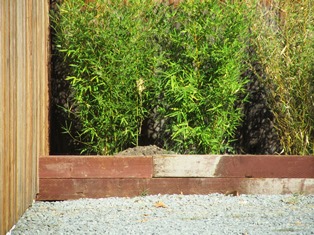
Stacked 6-by-6-foot lumber holds bamboo. Although one board needs staining, we don’t complain because the lumber was free
Gunshot Triggers Howls and Cackles in the Hood
Farm life isn’t always quiet. Night before last, a shot rang out around 11:00 p.m. It happened after some people in the neighborhood had engaged in a running argument, lasting hours.
My husband and I heard the arguing during our romantic dinner on the patio. His birthday is tomorrow and we celebrate birthdays all week, you see.
Hubby said he knew the sound of gunshots when he heard them. He was even more certain he’d heard the words, “We got to get out of here!” I was tempted to dive under the bed because people on the run with guns . . . well, that could be dangerous.
In the dark, you don’t know what has happened. I write mysteries. I’m thinking, “is there a body on the adjacent property?”
Three uniformed police officers arrive with nightsticks in their duty belts and guns in their holsters. With their flashlights drawn and turned on, they searched for a way into fortress that the neighbor has built or a means to see behind the tarps the neighbor has strung to hide his backyard and sheds.
Over the barking of the neighbor’s pit bull, I heard one officer tell the others, “This is like the Beverly Hillbillies. We’re notifying Code Enforcement.”
Glad it wasn’t our place they were talking about. We’ve been renovating . . . but neatly. Still, there’s the unfinished porch, the pile of lumber . . . .
I watched the erratic beams of their flashlights as they searched. Then . . . here they come, lights bobbing, down our driveway. They want to see if they can penetrate the fortress of the Beverly Hillbillies from another direction. Our house is in close proximity.
My husband went searching for a ladder. Call me silly, but I thought it would be the tall, thin officer, who would climb up. No, that would be too logical. It was the short, chunky one scaling into the heights, disappearing into the elm tree. Did I mention the tree has an almost impenetrable canopy in summer? Not surprising that he couldn’t see anything.
The officers decided on a look-see from the rear. My hubby guided them through a field, past the apiary and chicken house.
Roosting chickens are usually quiet. No doubt, you’ve heard the expression, “Going to bed with the chickens, rising with the rooster.” To say my hens were alarmed might be an understatement. They’d been roused from their slumber and cackled like there was no tomorrow. I realize there’s a bit of irony in the fact that our place is called the Henny Penny Farmette after Chicken Little’s story about the acorn falling on her head. This could have been the sky falling. They cackled like it was.
The deafening cackles agitated the neighbor’s pit bull, whose incessant barking got all the dogs in the hood howling. A fire engine shot by, sirens blaring. I took an aspirin, waited for my husband to return and the officers to leave.
Back in bed, who could sleep? I worried about when about when Code Enforcement might show up to cite the Beverly Hillbillies. Would the officers look over the fence and cite us as well? Code Enforcement aside, a gun-toter could hide behind our pile of porch lumber. We gotta get that porch finished.
But, like I said, it’s my husband’s birthday. He’s feeling romantic this week and not easily pushed. See my conundrum?
Get Ready for Blackberry Season
Southwest of the farmette lie the Santa Cruz mountains where blackberries grow wild. I know because I lived in those mountains and for many years hiked the environs of the mountain towns of Ben Lomond, Boulder Creek, Felton.
Nestle in the foothills, Los Gatos maintains Vasona Park where blackberries grow wild along the hiking/biking trail near a creek. I’ve been there several times this summer. Invariably, when I walk the trail in August or September and taste a ripe, freshly-picked blackberry, the sweetness and sprightly flavor evoke happy memories of summers past.
Our Henny Penny Farmette is located an hour and a half north of the Santa Cruz Mountains. Here we are situated in the shadow of Mount Diablo, but we have the kind of climate blackberries love. What is lacking is ample water that the plants need to thrive.
Blackberries require a deep soil and here we have clay (which can suffocate the berries because of the lack of good drainage the roots need). But we’ve helped the berries along by aerating and amending the soil with nutrients and with ground corn cob, aged horse manure, and compost.
Our trailing blackberries grow supported on a trellis. Use a two-wire trellis to avoid bending the canes too severely and to enable intertwining of the canes.
Last year, we planted a few of the semi-erect thornless berry vines. The Evergreen and Thornless Evergreen are commercial varieties and are extremely productive. The berries are large, black, firm, and sweet, pretty much perfect for eating out of your hand or using in a cobbler or pie. You can also make jam with blackberries alone or in combination with other fruits.
Some varieties can be so prodigious and hardy, adapting to the wild, that they are considered in some states and counties as noxious weeds, or pests. One species is the Himalaya cultivar. Its berries are shiny, black, about 1-inch long and the vines produce fruit with medium to large seeds. It quickly spreads and is difficult to control and eradicate.
The season for ripened blackberries is still a few weeks away, but watch for vines in the wild or plant some in your garden. Fall to spring is the best time for planting most berries.
Check with your local garden center for the right time to plant in your garden zone. Blackberries are perennial so the roots survive for many years, especially if the soil is loamy, well drained, and located in full sun to partial shade. For more information, see http://www.weeksberry.com/berryfiles/files/Blackberry.pdf.
Sunflowers-A Source of Beauty and Food
Sunflowers have inspired human expression for centuries. The Incas made the sunflower a symbol of their god. In Europe, sunflowers symbolized kingship and were cultivated in gardens, at least until the 18th Century when they fell out of favor. The artist Vincent Van Gogh immortalized these sun-facing flowers in his paintings that bear witness to the hot summers he spent in Arles.
In fact, nothing symbolizes summer like the sunny faces of sunflowers. That image of beauty is a widely used motif in garden art and home goods. Freshly cut sunflowers in a jar, vase, or tin can brighten any room in which they are placed.
Native Americans ate the seeds or ground them for use in breads and cakes and used the dyes for body paint and clothing. Today the seeds are dried and roasted or sold as natural. The oil is pressed and used in cooking. Sunflower seeds are high in protein and are considered a healthy snack.
Even children can plant and tend sunflowers; they are easy to grow. The giant cultivars require ample garden space but planted in a circle or square, they can become a living fort that children enjoy playing under. Sunflowers are heavy feeders, so amending the soil with compost and manure will benefit their growth cycle. The plants are not particular about soil type but they do need regular watering.
Sunflowers can bear a single head, containing petals and seeds, or several heads on a single stalk. They range in size from small to giant stalks of twenty feet or more. Giant heads grow as much as two feet across.
Depending on the cultivar, the centers of these lovely flowers range from dark brown or black, or gray and white striped. The seeds are a favorite food of squirrels and birds and honeybees. Here on our farmette, we grow sunflowers near the apiary along with lavender. High-value food sources keep the bees around to pollinate the rest of our garden. And I can’t resist putting a few small heads in a jar to brighten my kitchen window.
 Facebook
Facebook Goodreads
Goodreads LinkedIn
LinkedIn Meera Lester
Meera Lester Twitter
Twitter





